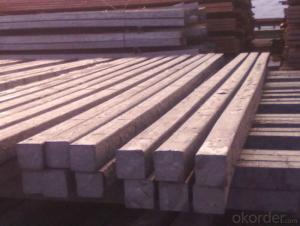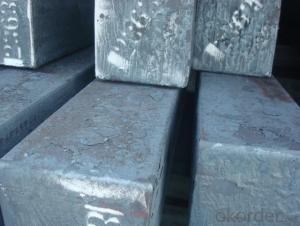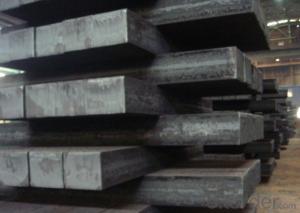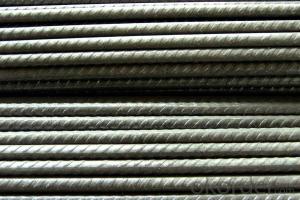Hot Rolled Steel Billet 3SP Standard 110mm
- Loading Port:
- Shanghai
- Payment Terms:
- TT OR LC
- Min Order Qty:
- 100 m.t.
- Supply Capability:
- 10000 m.t./month
OKorder Service Pledge
OKorder Financial Service
You Might Also Like
Structure of Hot Rolled Steel Billet 3SP Standard 110mm

Description of Hot Rolled Steel Billet 3SP Standard 110mm
Prepainted Rolled steel Coil is a kind of coated steel coil/sheet. With the cold rolled steel of different strength and thickness as substrate, it is produced through applying Al-Zn coat on both faces by hot dip process. In its coating, Al accounts for about 55%, Si 1.6%, while the remaining is Zn. Aluminum zinc coils enjoys both the physical protective feature and durability of Al and the electrochemical protective property of Zn. And its surface has bright silver color and regular embossed-like figure, which are highly decorative. RAL Scale Z35 Prepainted Rolled Steel Coil for Construction Roofing
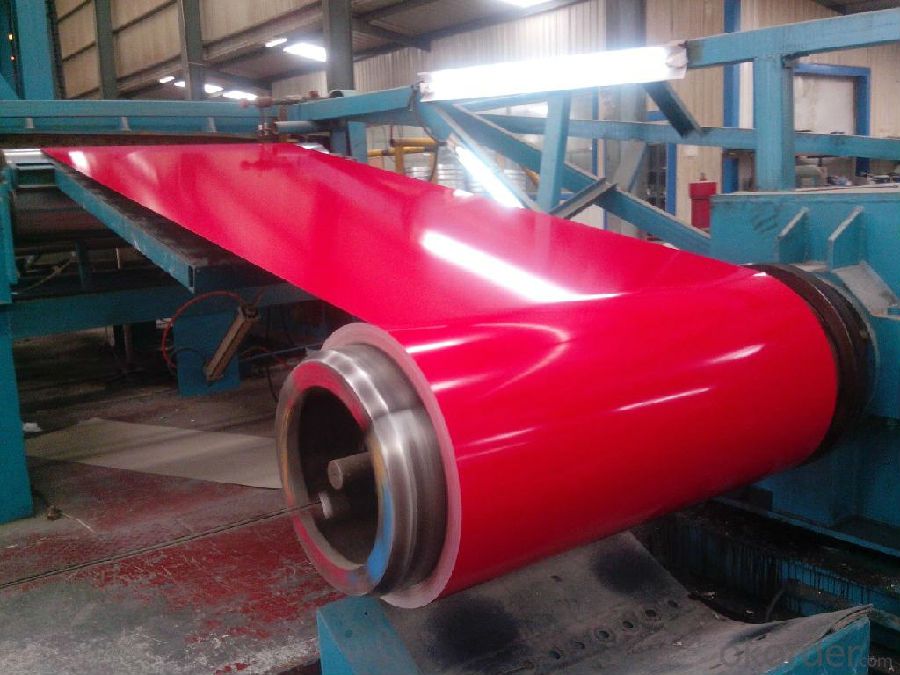
Main Feature of Hot Rolled Steel Billet 3SP Standard 110mm
1.Corrosion resistance: It mainly depends on the zinc protection. When the zinc being worn,
2. Heat resistance: steel sheet has excellent heat resistance, can withstand high temperatures over 300 centigrade, and is similar with aluminized steel high temperature oxidation resistance. It often used in chimney pipes, ovens, fluorescent lighting device and the device cover.
3. Heat reflective: Galvanized steel plate heat-reflective high rate is twice as galvanized steel, often used to make insulation materials. RAL Scale Z35 Prepainted Rolled Steel Coil for Construction Roofing
Applications of Hot Rolled Steel Billet 3SP Standard 110mm
1. Construction and building: roofing; ventilating duct; handrail; partition panel;etc.
2. Electric appliance: refrigerator; washing machine; refrigerator; DVD;etc.
3.Transportation: oil tank; gas tank;road sign; etc.
4.Agriculture constructions :barn; etc.RAL Scale Z35 Prepainted Rolled Steel Coil for Construction Roofing
5.Others:vending machine; game machine; auto parts spare parts etc.

Specifications of Hot Rolled Steel Billet 3SP Standard 110mm
Product | Hot Rolled Steel Billet 3SP Standard 110mm |
Material Grade | SGCC / SGCH / DX51D+AZ, etc |
Thickness | 0.5-3.0mm |
Width | 700-1500mm |
Tolerance | Thickness: +/-0.02mm , Width:+/-2mm |
Zinc-coating | AZ30-150g/m2 |
Technique | Raw material: Hot rolled steel coil --> Cold rolled_>hot dipped galvalume |
Surface | Dried, Chromated, Unoiled,RAL Scale Z35 Prepainted Rolled Steel Coil for Construction Roofing |
Spangle | Regular spangle , small spangle, zero spangle |
ID | 508MM 610MM |
Coil weight | 25MT max |
Export package | Cardboard inner sleeves, Waterproof paper, galvanized steel covered and steel strip packed |
FAQ of Hot Rolled Steel Billet 3SP Standard 110mm
We have organized several common questions for our clients,may help you sincerely:
1. What is the minimum order quantity ?
Our MOQ is 100 mt for each size each specification. Usually we can offer discount if can buy large QTY once. RAL Scale Z35 Prepainted Rolled Steel Coil for Construction Roofing
2. How long can we receive the product after ordering?
Our general delivery time is 30 days after confirmation, but so some special orders, we have offer special delivery time
3. How to guarantee the quality of the products?
We have established the international advanced quality management system ,every link from raw material to final product we have strict quality test;We resolutely put an end to unqualified products flowing into the market. At the same time, we will provide necessary follow-up service assurance.
4. What is the payment?
We accept T/T, L/C
- Q: Are there any alternative materials to steel billets in certain applications?
- Yes, there are several alternative materials to steel billets in certain applications. Some commonly used alternatives include aluminum billets, copper billets, and titanium billets. Each of these materials possesses unique properties and characteristics that make them suitable for specific applications where steel may not be the most ideal choice. For example, aluminum billets are lightweight and have excellent corrosion resistance, making them suitable for industries such as aerospace and automotive. Copper billets are known for their superior electrical conductivity, making them commonly used in electrical and electronic applications. Titanium billets offer exceptional strength, low density, and high heat resistance, making them suitable for industries such as aerospace, military, and medical. Ultimately, the choice of alternative material depends on the specific requirements and demands of the application in question.
- Q: How are steel billets used in the manufacturing of fasteners and fittings?
- Steel billets are used in the manufacturing of fasteners and fittings as they serve as the raw material from which these components are produced. These billets are heated and then shaped using various processes such as forging, extrusion, or machining to create the desired shape and size of the fasteners and fittings. The steel billets provide the necessary strength and durability required for these components to withstand the forces and loads they will encounter in their applications.
- Q: How do steel billets contribute to the overall durability of a product?
- Steel billets contribute to the overall durability of a product by providing a strong and solid foundation. These billets are made from high-quality steel and undergo various processes such as heating, rolling, and shaping to form the desired product. The use of steel billets ensures that the product has excellent strength, resilience, and resistance to wear and tear. This makes the product more durable and capable of withstanding heavy loads, extreme conditions, and prolonged usage.
- Q: How are steel billets used in the manufacturing of oil and gas industry components?
- Steel billets are used in the manufacturing of oil and gas industry components as they serve as the starting material for various products such as pipes, valves, fittings, and flanges. These billets are heated and shaped through processes like forging, rolling, or extrusion to create the desired form and strength required for the specific component. The resulting steel components are then used in the construction and operation of oil and gas infrastructure, ensuring reliability, durability, and performance in challenging operating conditions.
- Q: How do steel billets compare to other types of metal billets?
- Steel billets have several advantages over other types of metal billets. Firstly, steel is known for its exceptional strength and durability, making steel billets highly resistant to wear and tear. This makes them suitable for a wide range of applications, including construction, automotive, and manufacturing industries. Additionally, steel billets have excellent heat resistance, allowing them to withstand high temperatures without deforming or losing their structural integrity. This makes steel billets ideal for use in the production of components that are exposed to extreme heat, such as engine parts or industrial machinery. Moreover, steel billets offer versatility in terms of shape and size. They can be easily molded and formed into various shapes, enabling manufacturers to create complex and intricate designs. This flexibility makes steel billets preferred in industries where customized or intricate parts are required. Furthermore, steel billets are highly recyclable, making them a sustainable choice. The recycling process of steel requires significantly less energy compared to other metals, resulting in reduced carbon emissions and environmental impact. This aspect has led to an increased preference for steel billets in industries that prioritize sustainability and environmental responsibility. In summary, steel billets outperform other types of metal billets due to their exceptional strength, heat resistance, versatility, and recyclability. These properties make steel billets a preferred choice for numerous industries, offering a combination of durability, functionality, and environmental sustainability.
- Q: What is the typical surface finish of a steel billet?
- Depending on the specific application and processing method, the surface finish of a steel billet can vary. Generally, steel billets are produced with a rough surface finish that may have imperfections like scale, oxide layers, or minor irregularities. This is primarily because of the manufacturing process involving hot rolling or casting. Hot rolling is a common method for producing steel billets. In this process, the steel is heated to high temperatures and shaped by passing it through rollers. This high-temperature process can result in the formation of scale or oxide layers on the billet's surface, making it appear rough and textured. Similarly, steel billets produced through casting methods like continuous casting or ingot casting may also have a rough surface finish. During these processes, the molten steel solidifies in molds, leading to surface imperfections like cracks, pits, or unevenness. However, it's important to note that the surface finish of steel billets can be improved through additional processes such as descaling, shot blasting, or grinding. These processes help remove scale, oxide layers, or other imperfections, resulting in a smoother and more uniform surface finish. Furthermore, steel billets intended for specific applications like precision machining or forging may undergo additional surface treatments like polishing or coating to achieve the desired finish. In conclusion, the typical surface finish of a steel billet is rough and may have scale, oxide layers, or minor irregularities. However, various additional processes can be used to improve the surface finish according to specific requirements and applications.
- Q: How do steel billets contribute to the manufacturing of defense equipment?
- Steel billets are an essential raw material in the manufacturing of defense equipment due to their high strength, durability, and versatility. These billets serve as the building blocks for various components, such as armored vehicles, aircraft carriers, submarines, and weapons systems. Through careful shaping, forging, and machining processes, steel billets can be transformed into critical parts with specific properties, such as ballistic resistance, structural integrity, and corrosion resistance. Therefore, steel billets play a crucial role in ensuring the reliability and effectiveness of defense equipment, providing the necessary strength and performance required for military operations and national security.
- Q: What are the different types of straightening methods used for steel billets?
- Steel billets can be straightened using various methods, depending on specific requirements and desired outcomes. These methods encompass: 1. Roller Straightening: By passing the steel billets through a series of rollers, pressure is applied in different directions to achieve straightness. Rollers can be adjusted to target specific areas that may be bent or twisted. 2. Hydraulic Straightening: Employing hydraulic presses, pressure is exerted on the billets either in a single or multiple directions. Adjustments can be made to attain the desired level of straightness. 3. Heat Straightening: This method involves heating the bent or twisted sections of the steel billets and using hydraulic or mechanical tools to straighten them. The heat softens the steel, simplifying the reshaping process. 4. Hammering: A conventional technique where skilled workers manually reshape the billets using hammers and anvils. This method necessitates a high level of skill and precision to achieve the desired straightness. 5. Magnetic Straightening: Employing magnetic fields, this non-contact method applies forces to the steel billets and straightens them. It is often implemented for smaller and thinner billets to avoid damage or distortion caused by other methods. Each straightening method has its own advantages and limitations. The choice of method depends on various factors, such as billet size and thickness, required level of straightness, and available equipment and resources.
- Q: What are the main factors affecting the corrosion resistance of alloy steel billets?
- The main factors affecting the corrosion resistance of alloy steel billets are the composition of the alloy, the presence of impurities, the surface treatment, and the environmental conditions in which the billets are exposed to.
- Q: What are the main factors affecting the hardenability of steel billets?
- The main factors affecting the hardenability of steel billets are the carbon content, alloying elements, cooling rate, and the size and shape of the billet.
Send your message to us
Hot Rolled Steel Billet 3SP Standard 110mm
- Loading Port:
- Shanghai
- Payment Terms:
- TT OR LC
- Min Order Qty:
- 100 m.t.
- Supply Capability:
- 10000 m.t./month
OKorder Service Pledge
OKorder Financial Service
Similar products
Hot products
Hot Searches
Related keywords





